Jackson M.J. Micro and Nanomanufacturing
Подождите немного. Документ загружается.

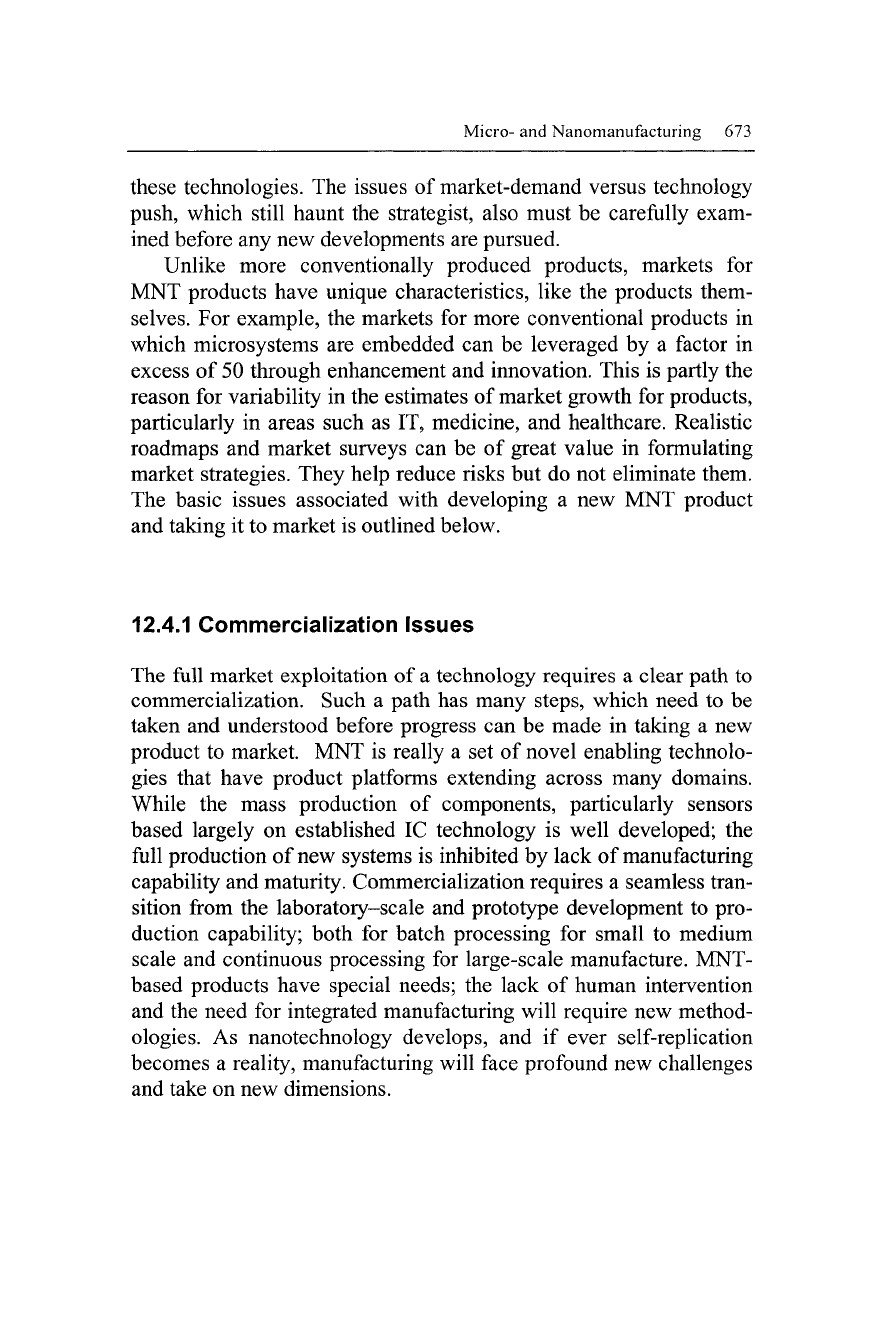
Micro- and Nanomanufacturing 673
these technologies. The issues of market-demand versus technology
push, which still haunt the strategist, also must be carefully exam-
ined before any new developments are pursued.
Unlike more conventionally produced products, markets for
MNT products have unique characteristics, like the products them-
selves. For example, the markets for more conventional products in
which microsystems are embedded can be leveraged by a factor in
excess of 50 through enhancement and innovation. This is partly the
reason for variability in the estimates of market growth for products,
particularly in areas such as IT, medicine, and healthcare. Realistic
roadmaps and market surveys can be of great value in formulating
market strategies. They help reduce risks but do not eliminate them.
The basic issues associated with developing a new MNT product
and taking it to market is outlined below.
12.4.1 Commercialization Issues
The full market exploitation of a technology requires a clear path to
commercialization. Such a path has many steps, which need to be
taken and understood before progress can be made in taking a new
product to market. MNT is really a set of novel enabling technolo-
gies that have product platforms extending across many domains.
While the mass production of components, particularly sensors
based largely on established IC technology is well developed; the
full production of new systems is inhibited by lack of manufacturing
capability and maturity. Commercialization requires a seamless tran-
sition from the laboratory-scale and prototype development to pro-
duction capability; both for batch processing for small to medium
scale and continuous processing for large-scale manufacture. MNT-
based products have special needs; the lack of human intervention
and the need for integrated manufacturing will require new method-
ologies. As nanotechnology develops, and if ever self-replication
becomes a reality, manufacturing will face profound new challenges
and take on new dimensions.
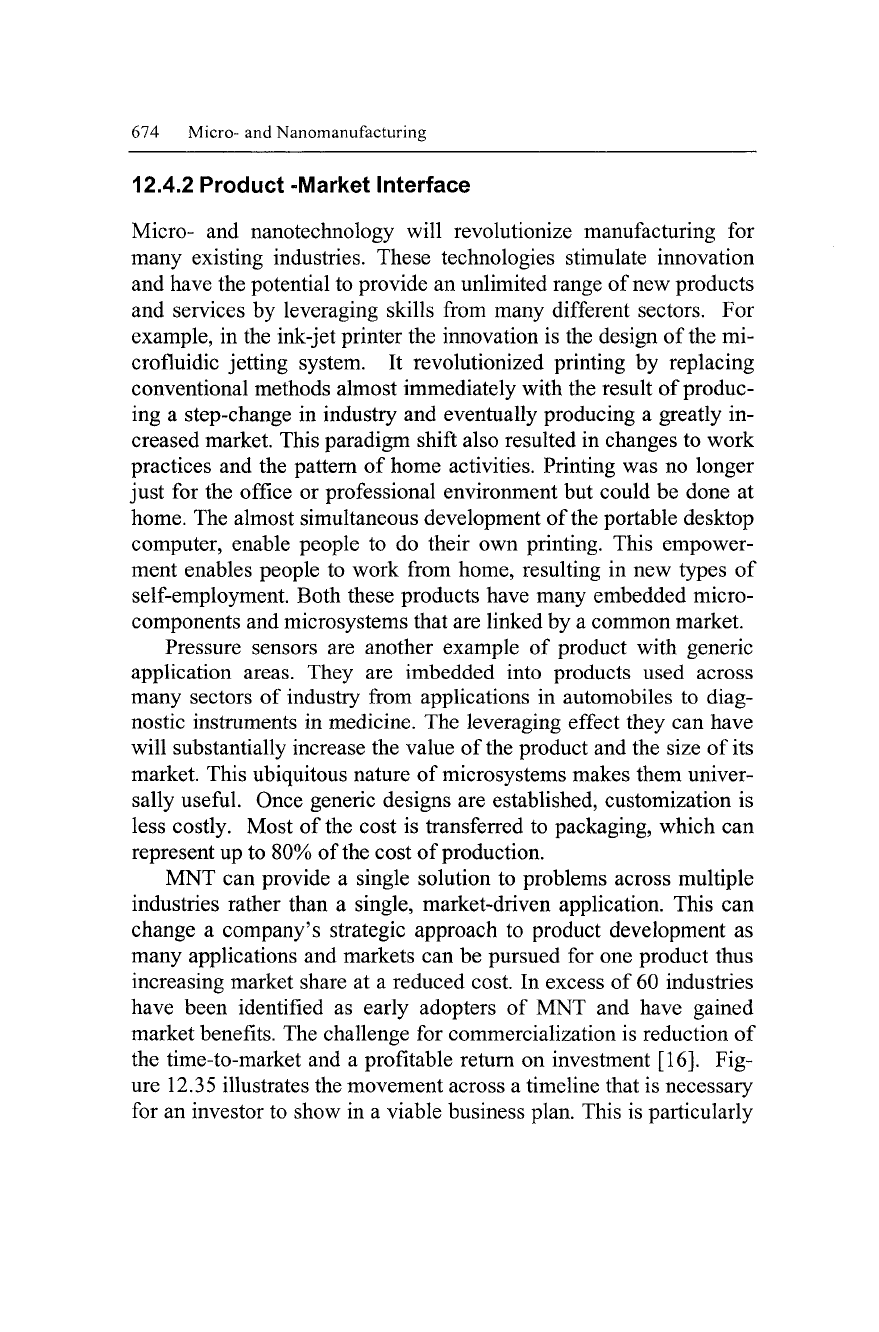
674 Micro- and Nanomanufacturing
12.4.2 Product -Market Interface
Micro- and nanotechnology will revolutionize manufacturing for
many existing industries. These technologies stimulate innovation
and have the potential to provide an unlimited range of new products
and services by leveraging skills from many different sectors. For
example, in the ink-jet printer the innovation is the design of the mi-
crofluidic jetting system. It revolutionized printing by replacing
conventional methods almost immediately with the result of produc-
ing a step-change in industry and eventually producing a greatly in-
creased market. This paradigm shift also resulted in changes to work
practices and the pattern of home activities. Printing was no longer
just for the office or professional environment but could be done at
home. The almost simultaneous development of the portable desktop
computer, enable people to do their own printing. This empower-
ment enables people to work from home, resulting in new types of
self-employment. Both these products have many embedded micro-
components and microsystems that are linked by a common market.
Pressure sensors are another example of product with generic
application areas. They are imbedded into products used across
many sectors of industry from applications in automobiles to diag-
nostic instruments in medicine. The leveraging effect they can have
will substantially increase the value of the product and the size of its
market. This ubiquitous nature of microsystems makes them univer-
sally useful. Once generic designs are established, customization is
less costly. Most of the cost is transferred to packaging, which can
represent up to 80% of the cost of production.
MNT can provide a single solution to problems across multiple
industries rather than a single, market-driven application. This can
change a company's strategic approach to product development as
many applications and markets can be pursued for one product thus
increasing market share at a reduced cost. In excess of 60 industries
have been identified as early adopters of MNT and have gained
market benefits. The challenge for commercialization is reduction of
the time-to-market and a profitable return on investment [16]. Fig-
ure 12.35 illustrates the movement across a timeline that is necessary
for an investor to show in a viable business plan. This is particularly
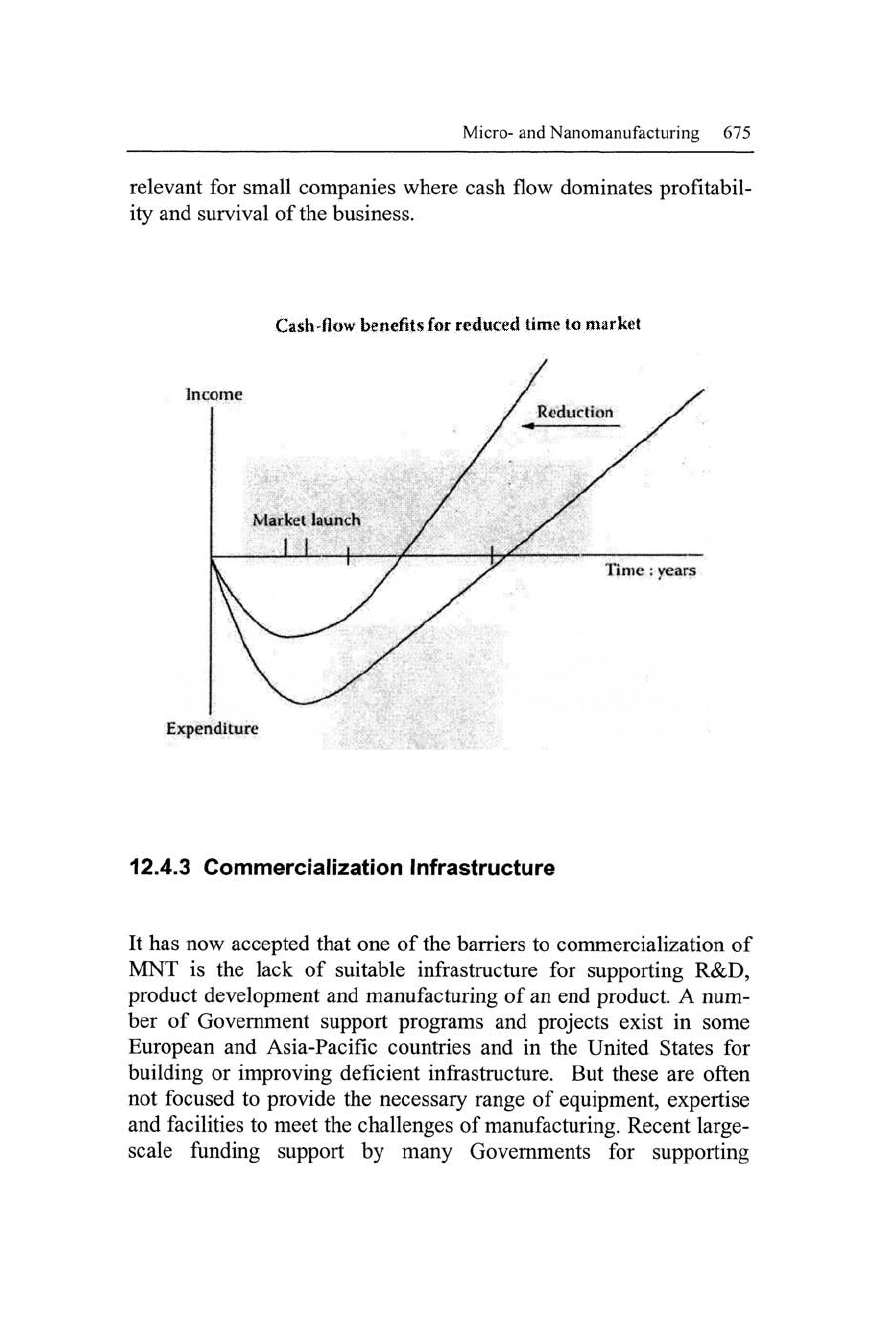
Micro- and Nanomanufacturing 675
relevant for small companies where cash flow dominates profitabil-
ity and survival of the business.
Cash tew benefitssibr reduced time to market
Income
Expenditure
Fig. 12.35. Movement across a timeline that is necessary for an investor to show a
viable business plan
12.4.3 Commercialization Infrastructure
It has now accepted that one of the barriers to commercialization of
MNT is the lack of suitable infrastructure for supporting R&D,
product development and manufacturing of an end product. A num-
ber of Government support programs and projects exist in some
European and Asia-Pacific countries and in the United States for
building or improving deficient infrastructure. But these are often
not focused to provide the necessary range of equipment, expertise
and facilities to meet the challenges of manufacturing. Recent large-
scale funding support by many Governments for supporting
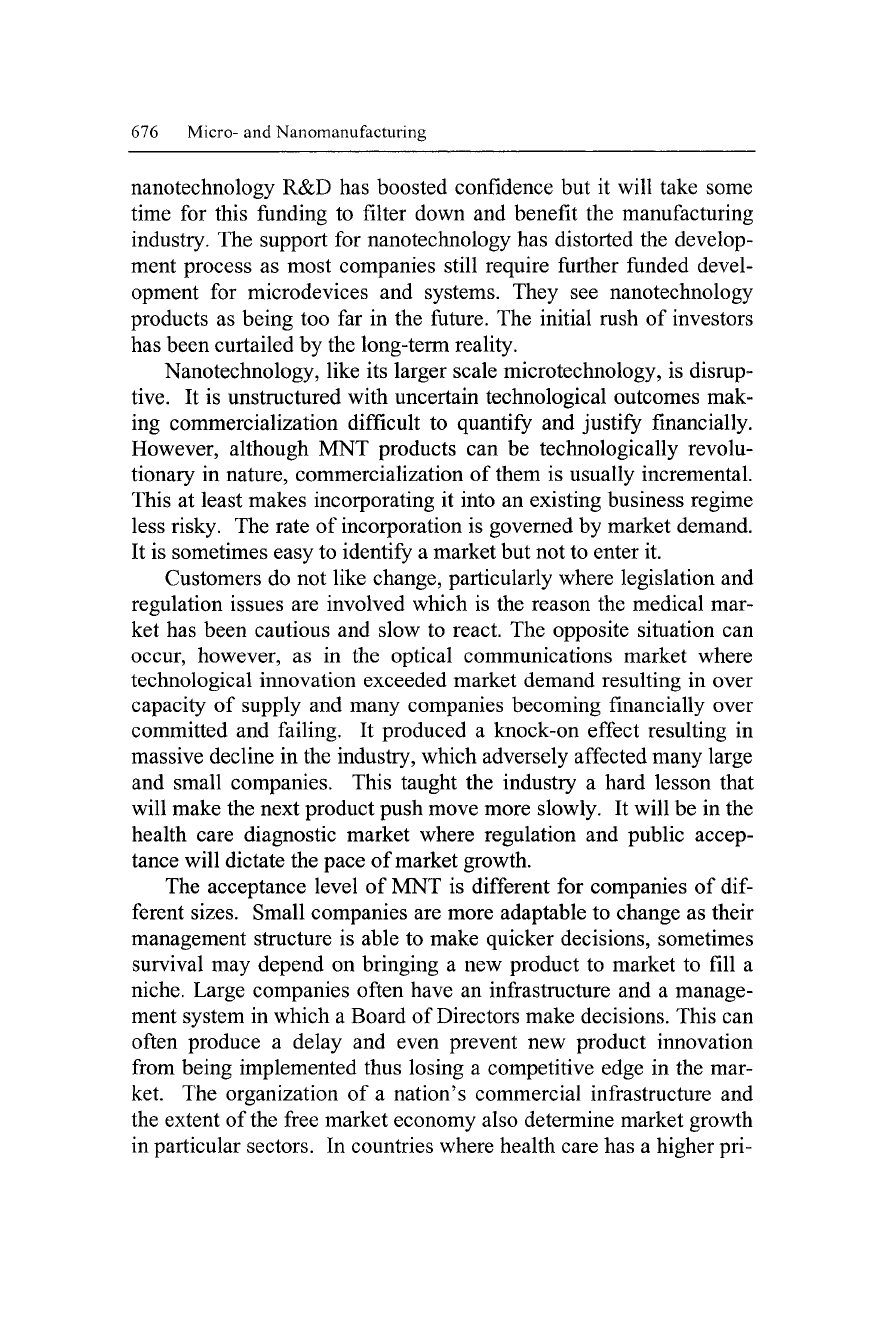
676 Micro- and Nanomanufacturing
nanotechnology R&D has boosted confidence but it will take some
time for this funding to filter down and benefit the manufacturing
industry. The support for nanotechnology has distorted the develop-
ment process as most companies still require further funded devel-
opment for microdevices and systems. They see nanotechnology
products as being too far in the future. The initial rush of investors
has been curtailed by the long-term reality.
Nanotechnology, like its larger scale microtechnology, is disrup-
tive.
It is unstructured with uncertain technological outcomes mak-
ing commercialization difficult to quantify and justify financially.
However, although MNT products can be technologically revolu-
tionary in nature, commercialization of them is usually incremental.
This at least makes incorporating it into an existing business regime
less risky. The rate of incorporation is governed by market demand.
It is sometimes easy to identify a market but not to enter it.
Customers do not like change, particularly where legislation and
regulation issues are involved which is the reason the medical mar-
ket has been cautious and slow to react. The opposite situation can
occur, however, as in the optical communications market where
technological innovation exceeded market demand resulting in over
capacity of supply and many companies becoming financially over
committed and failing. It produced a knock-on effect resulting in
massive decline in the industry, which adversely affected many large
and small companies. This taught the industry a hard lesson that
will make the next product push move more slowly. It will be in the
health care diagnostic market where regulation and public accep-
tance will dictate the pace of market growth.
The acceptance level of MNT is different for companies of
dif-
ferent sizes. Small companies are more adaptable to change as their
management structure is able to make quicker decisions, sometimes
survival may depend on bringing a new product to market to fill a
niche. Large companies often have an infrastructure and a manage-
ment system in which a Board of Directors make decisions. This can
often produce a delay and even prevent new product innovation
from being implemented thus losing a competitive edge in the mar-
ket. The organization of a nation's commercial infrastructure and
the extent of the free market economy also determine market growth
in particular sectors. In countries where health care has a higher pri-
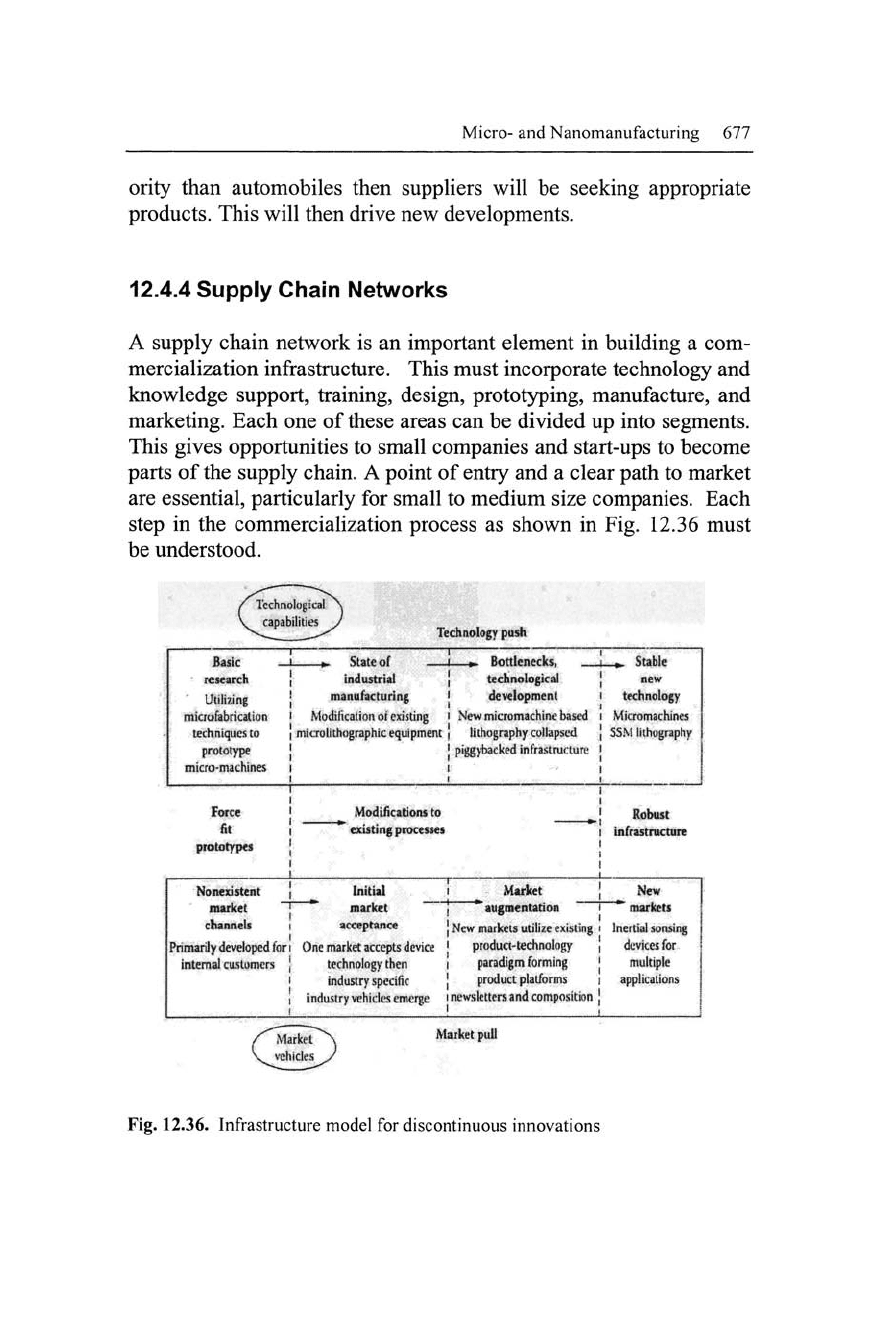
Micro- and Nanomanufacturing 677
ority than automobiles then suppHers will be seeking appropriate
products. This will then drive new developments.
12.4.4 Supply Chain Networks
A supply chain network is an important element in building a com-
mercialization infrastructure. This must incorporate technology and
knowledge support, training, design, prototyping, manufacture, and
marketing. Each one of these areas can be divided up into segments.
This gives opportunities to small companies and start-ups to become
parts of the supply chain. A point of entry and a clear path to market
are essential, particularly for small to medium size companies. Each
step in the commerciahzation process as shown in Fig. 12.36 must
be understood.
Technological
capabilities
Technology push
research
Utilizing
micrufabrication
techniques to
prototype
micro-machines
Force
fit
prototypes
Nonexistent
market ~
channels
Primarily developed for
internal caUomcrs
industrial
manufacturing
Modification oi existing
micrulithographic equipment
Modifications to
existing processes
Initial
market
acceptance
One market accepts device
technology then
industry specific
industry vchiclfs emerge
1 ^ Rnttlf>nerlcs,
technological
development
New micro machine based
lithography collapsed
piggybacked infrastructure
Market
* augmentation
New markets utilize existing
product-technology
paradigm forming
product platforms
newsletters and composition
^ <itMp
new
technology
Micromachincs
SSM lithography |
Robust
infrastructure
New
*" markets
Inertia! sonsing
devices for !
multiple
applications
Market pull
Fig. 12.36. Infrastructure model for discontinuous innovations
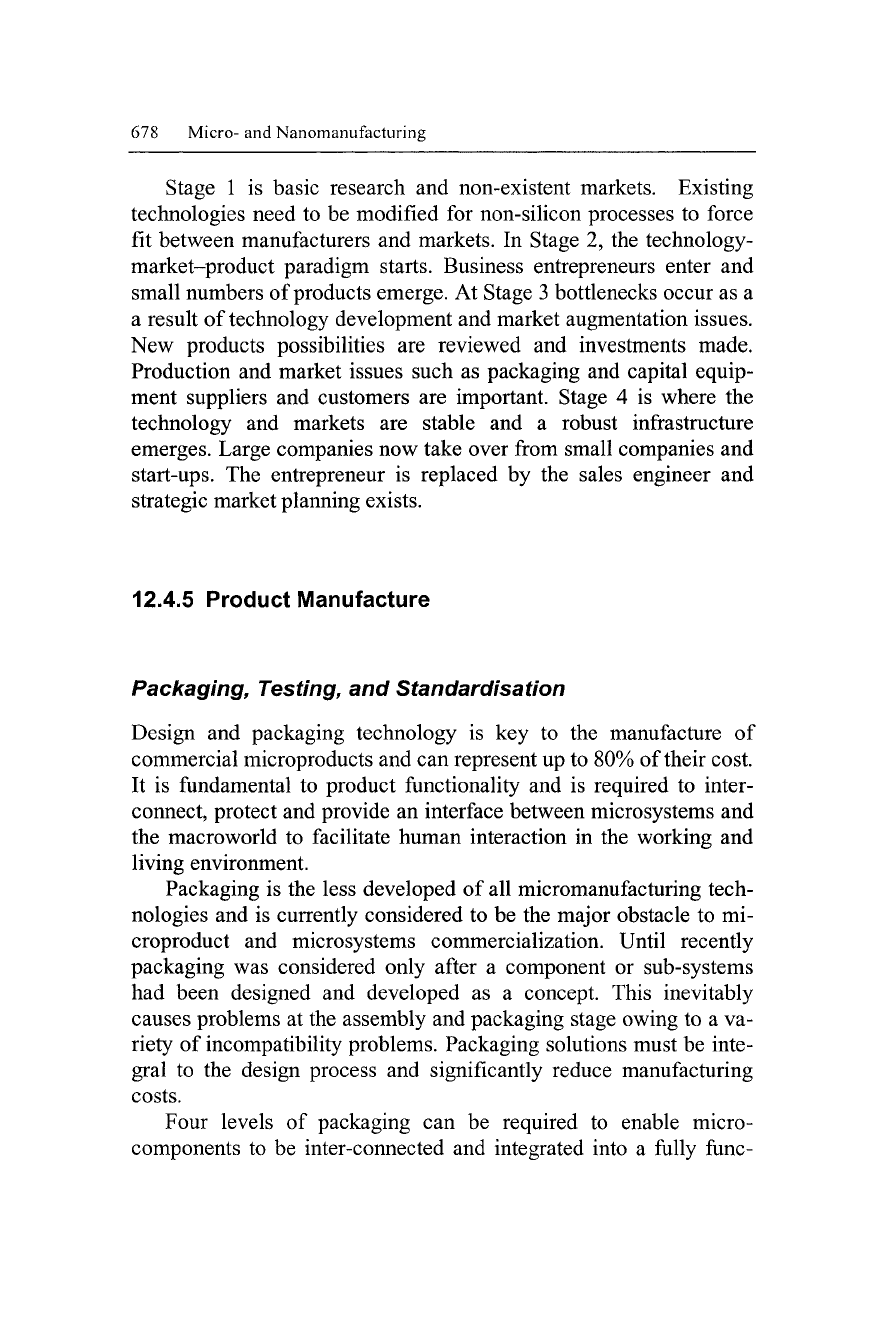
678 Micro- and Nanomanufacturing
Stage 1 is basic research and non-existent markets. Existing
technologies need to be modified for non-silicon processes to force
fit between manufacturers and markets. In Stage 2, the technology-
market-product paradigm starts. Business entrepreneurs enter and
small numbers of products emerge. At Stage 3 bottlenecks occur as a
a result of technology development and market augmentation issues.
New products possibilities are reviewed and investments made.
Production and market issues such as packaging and capital equip-
ment suppliers and customers are important. Stage 4 is where the
technology and markets are stable and a robust infrastructure
emerges. Large companies now take over from small companies and
start-ups. The entrepreneur is replaced by the sales engineer and
strategic market planning exists.
12.4.5 Product Manufacture
Packaging, Testing, and Standardisation
Design and packaging technology is key to the manufacture of
commercial microproducts and can represent up to 80% of their cost.
It is fundamental to product functionality and is required to inter-
connect, protect and provide an interface between microsystems and
the macroworld to facilitate human interaction in the working and
living environment.
Packaging is the less developed of all micromanufacturing tech-
nologies and is currently considered to be the major obstacle to mi-
croproduct and microsystems commercialization. Until recently
packaging was considered only after a component or sub-systems
had been designed and developed as a concept. This inevitably
causes problems at the assembly and packaging stage owing to a va-
riety of incompatibility problems. Packaging solutions must be inte-
gral to the design process and significantly reduce manufacturing
costs.
Four levels of packaging can be required to enable micro-
components to be inter-connected and integrated into a fully func-
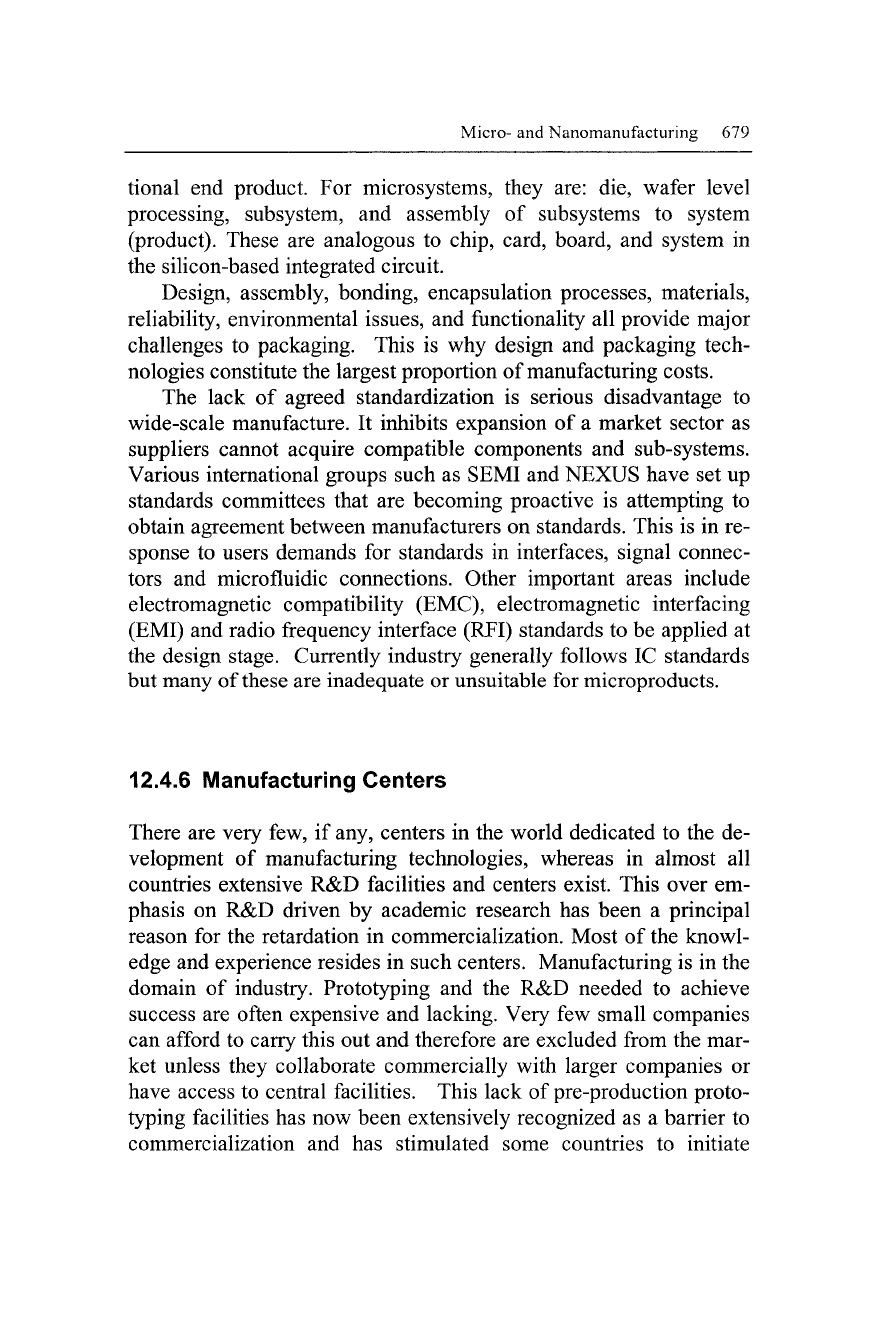
Micro- and Nanomanufacturing 679
tional end product. For microsystems, they are: die, wafer level
processing, subsystem, and assembly of subsystems to system
(product). These are analogous to chip, card, board, and system in
the silicon-based integrated circuit.
Design, assembly, bonding, encapsulation processes, materials,
reliability, environmental issues, and functionality all provide major
challenges to packaging. This is why design and packaging tech-
nologies constitute the largest proportion of manufacturing costs.
The lack of agreed standardization is serious disadvantage to
wide-scale manufacture. It inhibits expansion of a market sector as
suppliers cannot acquire compatible components and sub-systems.
Various international groups such as SEMI and NEXUS have set up
standards committees that are becoming proactive is attempting to
obtain agreement between manufacturers on standards. This is in re-
sponse to users demands for standards in interfaces, signal connec-
tors and microfluidic connections. Other important areas include
electromagnetic compatibility (EMC), electromagnetic interfacing
(EMI) and radio frequency interface (RFI) standards to be applied at
the design stage. Currently industry generally follows IC standards
but many of these are inadequate or unsuitable for microproducts.
12.4.6 Manufacturing Centers
There are very few, if any, centers in the world dedicated to the de-
velopment of manufacturing technologies, whereas in almost all
countries extensive R&D facilities and centers exist. This over em-
phasis on R&D driven by academic research has been a principal
reason for the retardation in commercialization. Most of the knowl-
edge and experience resides in such centers. Manufacturing is in the
domain of industry. Prototyping and the R&D needed to achieve
success are often expensive and lacking. Very few small companies
can afford to carry this out and therefore are excluded from the mar-
ket unless they collaborate commercially with larger companies or
have access to central facilities. This lack of pre-production proto-
typing facilities has now been extensively recognized as a barrier to
commercialization and has stimulated some countries to initiate
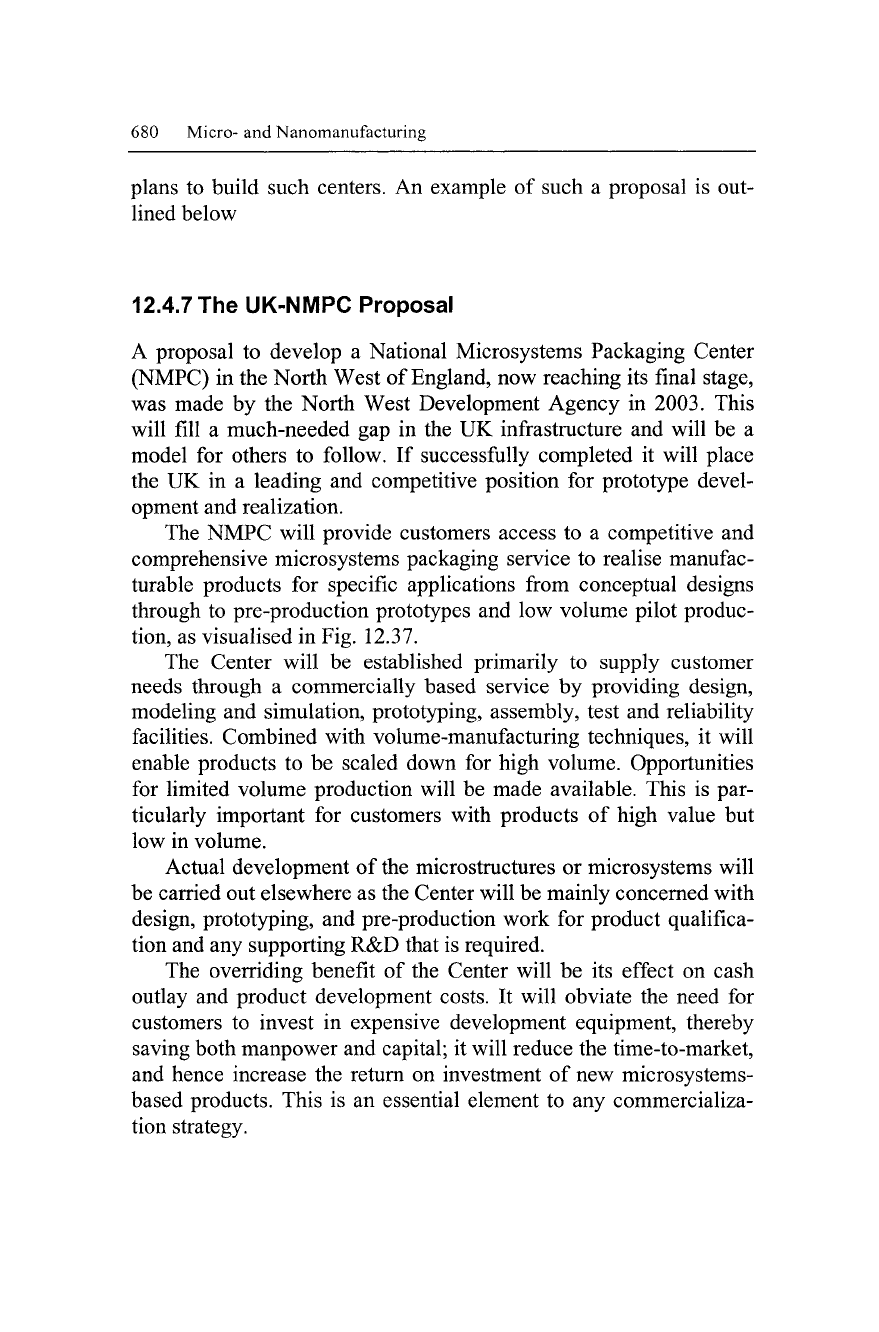
680 Micro- and Nanomanufacturing
plans to build such centers. An example of such a proposal is out-
lined below
12.4.7 The UK-NMPC Proposal
A proposal to develop a National Microsystems Packaging Center
(NMPC) in the North West of England, now reaching its final stage,
was made by the North West Development Agency in
2003.
This
will fill a much-needed gap in the UK infrastructure and will be a
model for others to follow. If successfully completed it will place
the UK in a leading and competitive position for prototype devel-
opment and realization.
The NMPC will provide customers access to a competitive and
comprehensive microsystems packaging service to realise manufac-
turable products for specific applications from conceptual designs
through to pre-production prototypes and low volume pilot produc-
tion, as visualised in Fig. 12.37.
The Center will be established primarily to supply customer
needs through a commercially based service by providing design,
modeling and simulation, prototyping, assembly, test and reliability
facilities. Combined with volume-manufacturing techniques, it will
enable products to be scaled down for high volume. Opportunities
for limited volume production will be made available. This is par-
ticularly important for customers with products of high value but
low in volume.
Actual development of the microstructures or microsystems will
be carried out elsewhere as the Center will be mainly concerned with
design, prototj^^ing, and pre-production work for product qualifica-
tion and any supporting R&D that is required.
The overriding benefit of the Center will be its effect on cash
outlay and product development costs. It will obviate the need for
customers to invest in expensive development equipment, thereby
saving both manpower and capital; it will reduce the time-to-market,
and hence increase the return on investment of new microsystems-
based products. This is an essential element to any commercializa-
tion strategy.
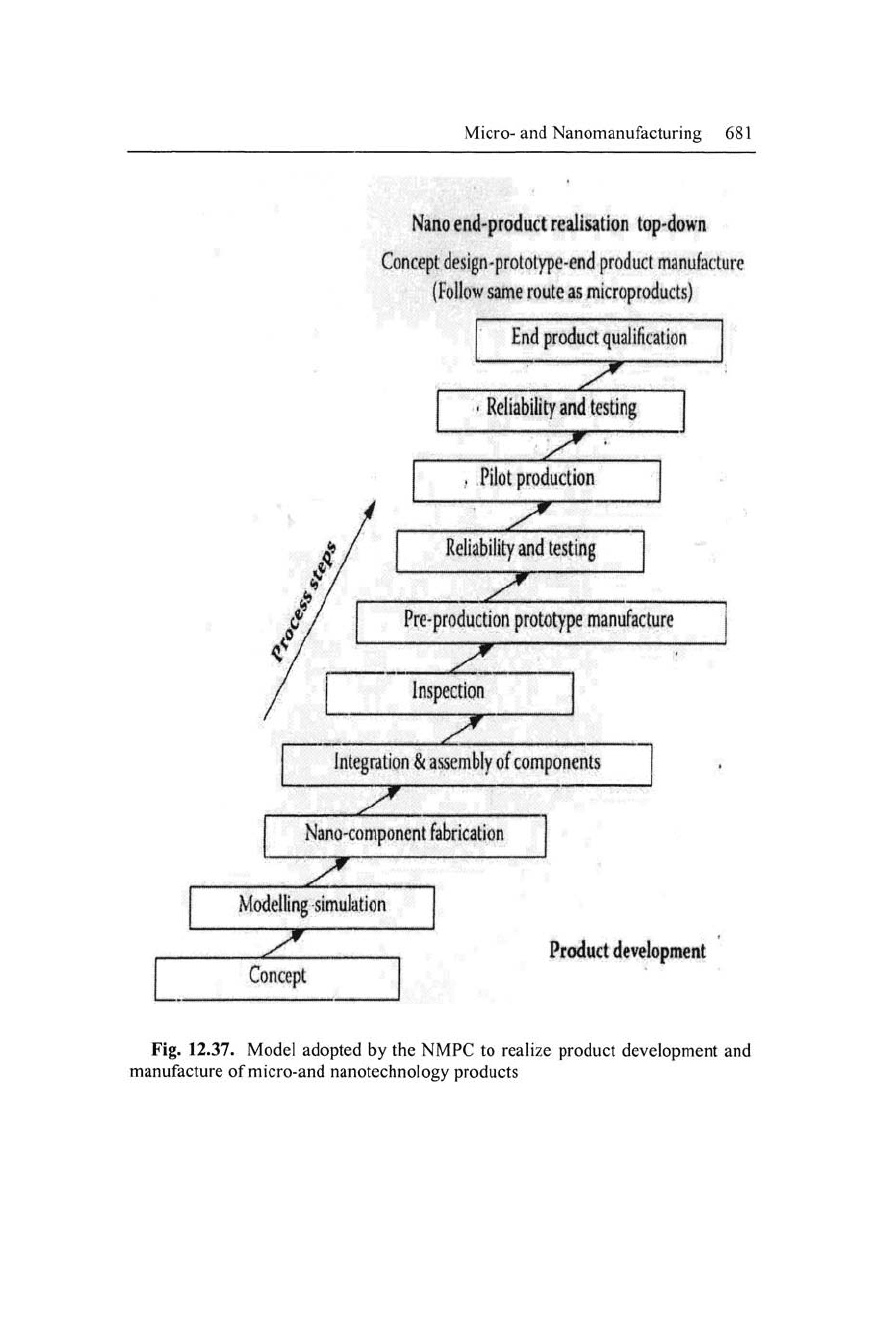
Micro-and Nanomanufacturing 681
Nano end-product realisation top-down
Concept dcsign-protol)T)c-end product manufacture
(Follow same route as microproducts)
End product qualification
yr
'
Reliability and testing
y-
.
Pilot production
/ y^
^1
1
Reliability and testing
1
if Pre-production prototype manufacture
^ / y^
/ \
Inspection
/^
Integration
&
assembly of components
y^
NanO'Componcnt fabrication
^ .
y'
. '
Modelling simulation
y^
Product developmpnt
Concept
Fig. 12.37. Model adopted by the NMPC to realize product development and
manufacture of micro-and nanotechnology products
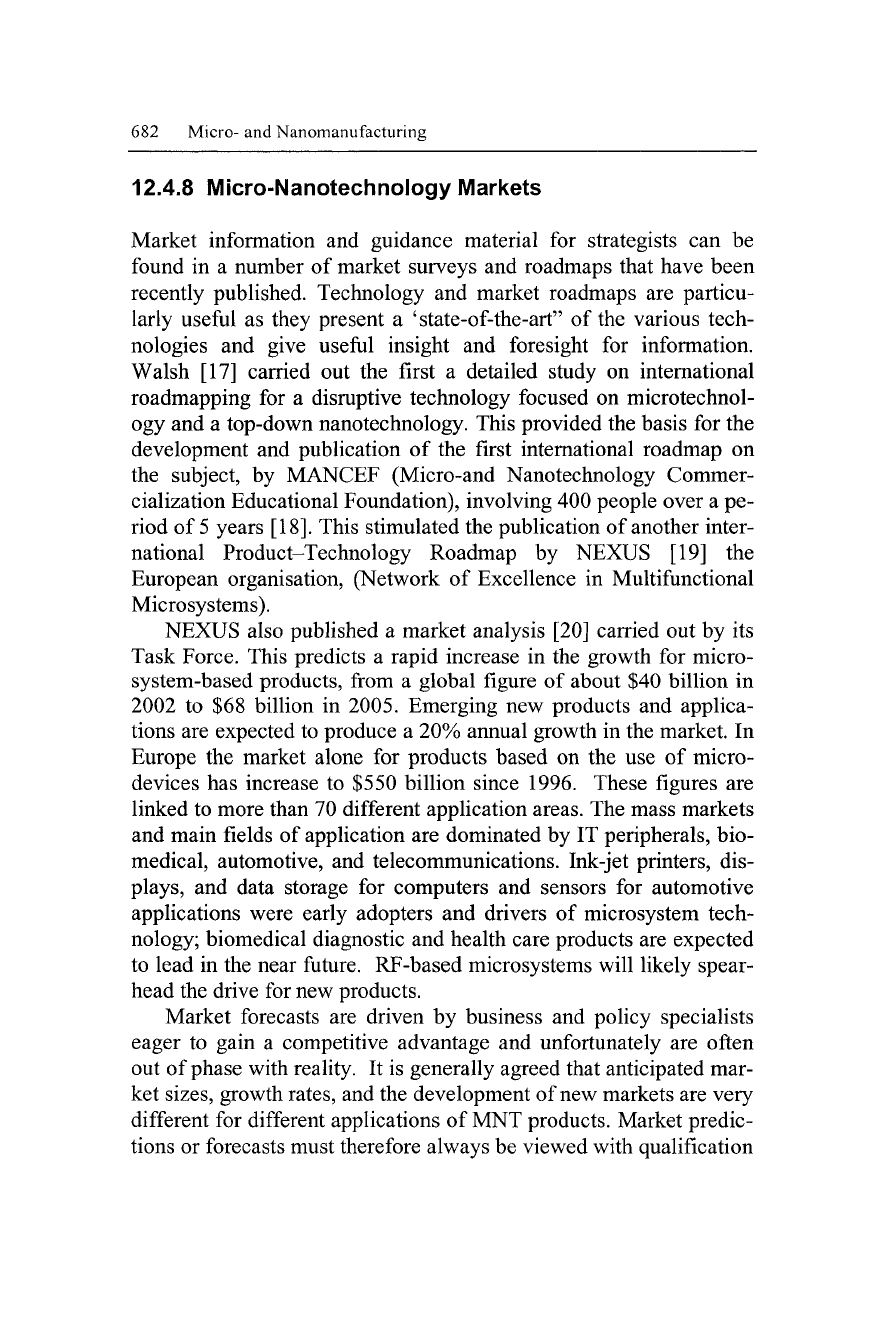
682 Micro- and Nanomanufacturing
12.4.8 Micro-Nanotechnology Markets
Market information and guidance material for strategists can be
found in a number of market surveys and roadmaps that have been
recently published. Technology and market roadmaps are particu-
larly useful as they present a 'state-of-the-art" of the various tech-
nologies and give useful insight and foresight for information.
Walsh [17] carried out the first a detailed study on international
roadmapping for a disruptive technology focused on microtechnol-
ogy and a top-down nanotechnology. This provided the basis for the
development and publication of the first international roadmap on
the subject, by MANCEF (Micro-and Nanotechnology Commer-
cialization Educational Foundation), involving 400 people over a pe-
riod of
5
years [18]. This stimulated the publication of another inter-
national Product-Technology Roadmap by NEXUS [19] the
European organisation, (Network of Excellence in Multifunctional
Microsystems).
NEXUS also published a market analysis [20] carried out by its
Task Force. This predicts a rapid increase in the growth for micro-
system-based products, from a global figure of about $40 billion in
2002 to $68 billion in 2005. Emerging new products and applica-
tions are expected to produce a 20% annual growth in the market. In
Europe the market alone for products based on the use of micro-
devices has increase to $550 billion since 1996. These figures are
linked to more than 70 different application areas. The mass markets
and main fields of application are dominated by IT peripherals, bio-
medical, automotive, and telecommunications. Ink-jet printers, dis-
plays,
and data storage for computers and sensors for automotive
applications were early adopters and drivers of microsystem tech-
nology; biomedical diagnostic and health care products are expected
to lead in the near future. RF-based microsystems will likely spear-
head the drive for new products.
Market forecasts are driven by business and policy specialists
eager to gain a competitive advantage and unfortunately are often
out of phase with reality. It is generally agreed that anticipated mar-
ket sizes, growth rates, and the development of new markets are very
different for different applications of MNT products. Market predic-
tions or forecasts must therefore always be viewed with qualification
